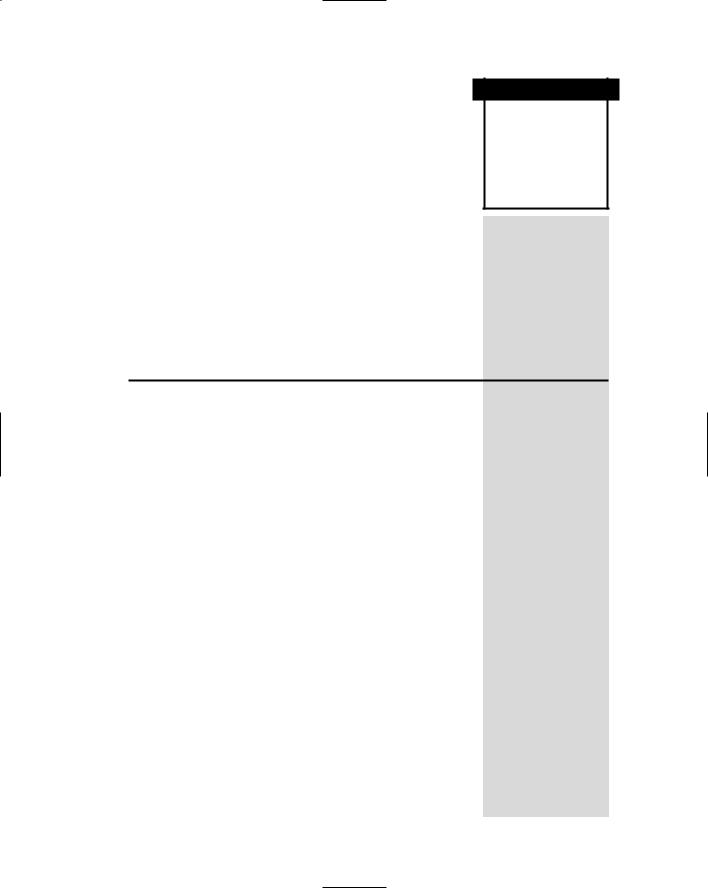
The Essential Guide to UI Design
.pdf

P A R T
One
The User Interface
—An Introduction
and Overview
The user interface is the most important part of any computer system. Why? It is the system to most users. It can be seen, it can be heard, and it can be touched. The piles of software code are invisible, hidden behind screens, keyboards, and the mouse. The goals of interface design are simple: to make working with a computer easy, productive, and enjoyable.
This first part of this book, Part 1, provides an introduction to the humancomputer interface. Chapter 1 examines what an interface is, its importance, and its history. Chapter 2 reviews the two dominant user interfaces, the graphical user interface (GUI) and the World Wide Web (WWW or Web). GUIs are looked at in terms of their components, characteristics, and advantages over the older text-based systems. Web interfaces are compared to both GUIs and conventional printed documents. The differing characteristics of three distinct Web environments, the Internet, intranet, and extranet are also summarized. The second chapter concludes with a statement of the basic underlying principles for interface design.
Part 2 of this book presents and examines an extensive collection of interface design guidelines. It is composed of 14 steps, beginning with “Know Your User or Client” and concluding with guidelines for usability testing. A complete overview of Part 2 can be found in the Part 2 introduction.


C H A P T E R
1
The Importance
of the User Interface
In these times of metaphors, mice, widgets/controls, links, applets, and usability, the user interface is being scrutinized, studied, written about, and talked about like never before. This welcome attention, along with the proliferation of usability laboratories and product testing, has significantly raised the usability of products being presented to users today. People’s voices have finally been heard above the din. Their frustration with complicated procedures and incomprehensible screens has finally become overwhelming. “We’re no longer going to peacefully accept products that mess up our lives and put everything we work on at risk,” they are saying. They’re also saying “That’s just the way it is” is no longer tolerable as an answer to a problem. Examples of good design, when they have occurred, have been presented as vivid proof that good design is possible.
Developers listened. Greatly improved technology in the late twentieth century eliminated a host of barriers to good interface design and unleashed a variety of new display and interaction techniques wrapped into a package called the graphical user interface or, as it is commonly called, GUI (pronounced “gooey”). Almost every graphical platform now provides a style guide to assist in product design. Software to aid the GUI design process proliferates. Hard on the heels of GUIs has come the amazingly fast intrusion of the World Wide Web into the everyday lives of people. Web site design has greatly expanded the range of users and introduced additional interface techniques such as multimedia. (To be fair, in some aspects it has dragged interface design backward as well, but more about that later.)
It is said that the amount of programming code devoted to the user interface now exceeds 50 percent. Looking back, great strides in interface design have occurred. Looking at the present, however, too many instances of poor design still abound. Looking ahead, it seems that much still remains to be done.
3

4 Part 1: The User Interface—An Introduction and Overview
Defining the User Interface
User interface design is a subset of a field of study called human-computer interaction (HCI). Human-computer interaction is the study, planning, and design of how people and computers work together so that a person’s needs are satisfied in the most effective way. HCI designers must consider a variety of factors: what people want and expect, what physical limitations and abilities people possess, how their perceptual and information processing systems work, and what people find enjoyable and attractive. Designers must also consider technical characteristics and limitations of the computer hardware and software.
The user interface is the part of a computer and its software that people can see, hear, touch, talk to, or otherwise understand or direct. The user interface has essentially two components: input and output. Input is how a person communicates his or her needs or desires to the computer. Some common input components are the keyboard, mouse, trackball, one’s finger (for touch-sensitive screens or pads), and one’s voice (for spoken instructions). Output is how the computer conveys the results of its computations and requirements to the user. Today the most common computer output mechanism is the display screen, followed by mechanisms that take advantage of a person’s auditory capabilities: voice and sound. The use of the human senses of smell and touch output in interface design still remain largely unexplored.
Proper interface design will provide a mix of well-designed input and output mechanisms that satisfy the user’s needs, capabilities, and limitations in the most effective way possible. The best interface is one that is not noticed, and one that permits the user to focus on the information and task at hand instead of the mechanisms used to present the information and perform the task.
The Importance of Good Design
With today’s technology and tools, and our motivation to create really effective and usable interfaces and screens, why do we continue to produce systems that are inefficient and confusing or, at worst, just plain unusable? Is it because:
1.We don’t care?
2.We don’t possess common sense?
3.We don’t have the time?
4.We still don’t know what really makes good design?
I take the view that the root causes are Number 4, with a good deal of Number 3 thrown in. We do care. But we never seem to have time to find out what makes good design, nor to properly apply it. After all, many of us have other things to do in addition to designing interfaces and screens. So we take our best shot given the workload and time constraints imposed upon us. The result, too often, is woefully inadequate.
I discounted the “we don’t possess common sense” alternative years ago. If, as I have heard thousands of times, interface and screen design were really a matter of common sense, developers would have produced almost identical screens for similar

Chapter 1: The Importance of the User Interface |
5 |
applications and functions for many years. When was the last time you saw two designers create almost identical screen solutions, based on the same requirements, without the aid of design guidelines or standards (or with them as well)?
A well-designed interface and screen are terribly important to users. They are their window to view the capabilities of the system, the bridge to the capabilities of the software. To many users it is the system, because it is one of the few visible components of the product its developers create. It is also the vehicle through which many critical tasks are presented. These tasks often have a direct impact on an organization’s relations with its customers, and its profitability.
A screen’s layout and appearance and a system’s navigation affect a person in a variety of ways. If they are confusing and inefficient, people will have greater difficulty doing their jobs and will make more mistakes. Poor design may even chase some people away from a system permanently. It can also lead to aggravation, frustration, and increased stress. One user relieved his frustrations with his computer through a couple of well-aimed bullets from a gun. Another user, in a moment of extreme exasperation, dropped his PC out of his upper-floor office window. Poor interface design can also have a huge financial cost to users and organizations. A critical system, such as one used in air traffic control or in a nuclear power plant, may compromise the safety of its users and/or the general public.
The Benefits of Good Design
Imagine the productivity benefits we could gain through proper design. Based on an actual system that requires processing of 4.8 million screens per year, an analysis established that if poor clarity forced screen users to spend one extra second per screen, almost one additional person-year would be required to process all screens. See Table 1.1. Twenty extra seconds in screen usage time adds an additional 14 personyears.
The benefits of a well-designed screen have also been under experimental scrutiny for many years. One researcher, for example, attempted to improve screen clarity and readability by making screens less crowded. Separate items, which had been combined on the same display line to conserve space, were placed on separate lines instead. The result: Screen users were about 20 percent more productive with the lesscrowded version. Other researchers reformatted a series of screens following many of the same concepts to be described in this book. The result: Screen users of the modified
Table 1.1: Impact of Inefficient Screen Design on Processing Time
ADDITIONAL SECONDS REQUIRED |
ADDITIONAL PERSON-YEARS REQUIRED |
PER SCREEN IN SECONDS |
TO PROCESS 4.8 MILLION SCREENS PER YEAR |
1 |
.7 |
|
|
5 |
3.6 |
|
|
10 |
7.1 |
20 |
14.2 |
|
|

6Part 1: The User Interface—An Introduction and Overview
screens completed transactions in 25 percent less time and with 25 percent fewer errors than those who used the original screens.
Another researcher has reported that reformatting inquiry screens following good design principles reduced decision-making time by about 40 percent, resulting in a savings of 79 person-years in the affected system. In a second study comparing 500 screens, it was found that the time to extract information from displays of airline or lodging information was 128 percent faster for the best format than for the worst.
Other studies have also shown that the proper formatting of information on screens does have a significant positive effect on performance. Cope and Uliano (1995) found that one graphical window redesigned to be more effective would save a company about $20,000 during its first year of use.
In recent years the productivity benefits of well-designed Web pages have also been scrutinized. Baca and Cassidy (1999) redesigned an organization’s homepage because users were complaining they were unable to find information they needed. These designers established a usability objective specifying that after redesign users should be able to locate the desired information 80 percent of the time. After one redesign, 73 percent of the searches were completed with an average completion time of 113 seconds. Additional redesigns eventually improved the success rate to 84 percent, and reduced the average completion time to 57 seconds. The improvement in search success rate between the first redesign and final redesign was 15 percent; the improvement in search time was about 50 percent. (This study also points out the value of iterative testing and redesign.)
Fath and Henneman (1999) evaluated four Web sites commonly used for online shopping. Participants performed shopping tasks at each site. In three of the Web sites about only one-half of the shopping tasks could be completed, and in the fourth, 84 percent were successful. (In the former, one-third of the shopping tasks could not be completed at all.) The more successful, and more usable, site task completion rate was about 65 percent higher than that of the less successful sites. We can only speculate how this might translate into dollars. Numerous other studies illustrating the productivity benefits of good interface design are sprinkled throughout this text.
Additional benefits also accrue from good design (Karat, 1997). Training costs are lowered because training time is reduced, support line costs are lowered because fewer assist calls are necessary, and employee satisfaction is increased because aggravation and frustration are reduced. Another benefit is, ultimately, that an organization’s customers benefit from the improved service they receive.
Identifying and resolving problems during the design and development process also has significant economic benefits. Pressman (1992) has shown that for every dollar spent fixing a problem during product design, $10 would be spent if the problem was fixed during development, and $100 would be spent fixing it after the product’s release. A general rule of thumb: Every dollar invested in system usability returns $10 to $100 (IBM, 2001).
How many screens are used each day in our technological world? How many screens are used each day in your organization? Thousands? Millions? Imagine the possible savings. Of course, proper screen design might also lower the costs of replacing “broken” PCs.

Chapter 1: The Importance of the User Interface |
7 |
A Brief History of the Human-Computer Interface
The need for people to communicate with each other has existed since we first walked upon this planet. The lowest and most common level of communication modes we share are movements and gestures. Movements and gestures are language-independent, that is, they permit people who do not speak the same language to deal with one another.
The next and higher level, in terms of universality and complexity, is spoken language. Most people can speak one language, some two or more. A spoken language is a very efficient mode of communication if both parties to the communication understand it.
At the third and highest level of complexity is written language. While most people speak, not everyone can write. But for those who can, writing is still nowhere near as efficient a means of communication as speaking.
In modern times we have the typewriter, another step upward in communication complexity. Significantly fewer people type than write. (While a practiced typist can find typing faster and more efficient than handwriting, the unskilled may not find this to be the case.) Spoken language, however, is still more efficient than typing, regardless of typing skill level.
Through its first few decades, a computer’s ability to deal with human communication was inversely related to what was easy for people to do. The computer demanded rigid, typed input through a keyboard; people responded slowly to using this device and with varying degrees of skill. The human-computer dialog reflected the computer’s preferences, consisting of one style or a combination of styles using keyboards, commonly referred to as Command Language, Question and Answer, Menu Selection, Function Key Selection, and Form Fill-In. For more details on the screens associated with these dialogs see Galitz (1992).
Throughout the computer’s history designers have been developing, with varying degrees of success, other human-computer interaction methods that utilize more general, widespread, and easier-to-learn capabilities: voice and handwriting. Systems that recognize human speech and handwriting now exist, although they still lack the universality and richness of typed input.
Introduction of the Graphical User Interface
Finally, in the 1970s, another dialog alternative surfaced. Research at Xerox’s Palo Alto Research Center provided an alternative to the typewriter — an interface that uses a form of human gesturing, the most basic of all human communication methods. The Xerox systems Altus and STAR introduced the mouse and pointing and selecting as the primary human-computer communication method. The user simply pointed at the screen, using the mouse as an intermediary. These systems also introduced the graphical user interface as we know it today. Ivan Sutherland from the Massachusetts Institute of Technology (MIT) is given credit for first introducing graphics with his Sketchpad program in 1963. Lines, circles, and points could be drawn on a screen using a light pen. Xerox worked on developing handheld pointing devices in the 1960s and patented a mouse with wheels in 1970. In 1974 Xerox patented today’s mouse, after a researcher was suddenly inspired to turn a trackball upside down.

8 Part 1: The User Interface—An Introduction and Overview
Xerox was never able to market STAR successfully, but Apple quickly picked up the concept and the Macintosh, released in 1984, was the first successful mass-market system. A new concept was born that revolutionized the human-computer interface. This new interface style quickly advanced as other products entered the marketplace.
In 1985 Microsoft released Windows 1.0 and Commodore introduced the Amiga 100. In 1987 Apple introduced Macintosh II, the first color Macintosh, and the X Window system became widely available. IBM’s contribution was the release of their System Application Architecture (including Common User Access) and Presentation Manager, intended as graphics operating system replacement for DOS.
Other developmental milestones include NeXT’s 1988 release of NeXTStep, the first to simulate a three-dimensional screen. Then, in 1989, several UNIX-based GUIs were released, including Open Look by AT&T and Sun Microsystems, and Motif for the Open Software Foundation by DEC and Hewlett-Packard. Open Look possessed an innovative appearance to avoid legal challenges. Finally, through the 1990s and 2000s, a succession of products and upgrades from Microsoft and Apple have appeared.
The Blossoming of the World Wide Web
The seeds of the Internet were planted in the early 1960s. J. C. R. Licklider of MIT proposed a global network of computers in 1962 and moved to the Defense Advanced Projects Research Agency (DARPA) to lead the development work. In 1969 the Internet, then known as Advanced Research Projects Agency Network (ARPANET), was brought online, which connected the computers at four major universities. Over the next few years, additional universities and research institutions were added to the network. One major goal of the Internet was to provide a communications network that would still function if some of the sites were destroyed by a nuclear attack.
Then in 1974 Bolt, Beranek, and Newman released Telenet, the first commercial version of ARPANET, and the public was exposed to how computers could be used in daily life. The early Internet was not user-friendly, being used only by computer experts, engineers, scientists, and librarians. The Internet continued to develop, mature, and expand throughout the 1970s. Through the late 1970s and into the 1980s, the common language of all Internet computers, TCP/IP, was created. The Internet as it is known today came into existence, and in 1982 the term Internet was formally coined. During the mid-1980s the increasing availability of PCs and super-minicomputers allowed many companies to also attach to the Internet. In 1990 ARPANET was decommissioned, leaving only the vast network of networks called the Internet. In 1991 Gopher, the first really friendly interface, was developed at the University of Minnesota. Although it was designed to ease campus communications, it was freely distributed on the Internet.
In 1989 another significant event took place when Tim Berners-Lee and others at the European Laboratory for Particle Physics (CERN) proposed a new protocol for distributing information. This protocol was based upon hypertext, a system of embedding links in text to go to other text. The language created in conjunction with the protocol was the HyperText Markup Language (HTML). In 1991 it was released on the Internet.

Chapter 1: The Importance of the User Interface |
9 |
HTML presented a limited set of objects and interaction styles, and in many ways was a step backward for interface design, especially when compared to the growth of interactive computing over the previous four decades. However, it was never intended to be as flexible as the GUI interface, and users were expected to be more technical and more interested in function than form.
The hypertext concept was first presented in 1945 by Vannevar Bush, and the term itself was coined in 1965. The first hypertext system released to the user community was the University of Vermont’s PROMIS in 1976. Apple’s HyperCard helped bring the idea to a wider audience in 1988. Berners-Lee’s work is credited with hatching the World Wide Web (WWW) in 1991. By definition, the World Wide Web is a global information space in which people can read and write using computers connected to the Internet. The term is often used as a synonym for the Internet, but this is incorrect. The Web is a service that operates over the Internet, just as e-mail operates over the Internet (Wikipedia.org, 2006).
In 1992 Delphi was the first to provide commercial online Internet access to subscribers. The first popular graphics-based hypertext browser was Mosaic, created by the National Center for Supercomputing Applications (NCSA) at the University of Illinois in 1993. Mosaic was one of the ingredients contributing to the initial overwhelming success of the Web, and it provided the basis for browsers to follow, including Netscape and Microsoft’s Internet Explorer. (NCSA halted development of Mosaic in 1997.)
The Netscape Navigator browser, first released in 1994, was the product of some of those who left the University of Illinois’ NCSA project to work for a newly founded company called Mosaic Communications. (Mosaic was later renamed Netscape Communications.) The potential for Web browsing software such as Mosaic had become obvious, and a need was waiting to be fulfilled. Netscape Navigator was the most successful browser, with its market share percentage in the 80s, until Microsoft declared war and entered the market with its Internet Explorer, also based upon Mosaic, in 1995. Opera, a browser for computers with small resources and not based upon Mosaic, also was released. That year also saw the coming of AOL, CompuServe, Prodigy, Yahoo, and Lycos. The Internet’s shift to a commercial entity was now complete. The National Science Foundation (NSF), which had been sponsoring the Internet, also ended its support that year. In 1994 The World Wide Web Consortium (W3C) was formed to promote and develop standards for the Web.
Throughout 1995 and 1996 the Internet Explorer–Netscape Navigator skirmishing continued. Microsoft’s most significant advancement was Internet Explorer 3.0, implementing features from Navigator 3 and other significant enhancements. In 1998, because of severe competition from Microsoft, Netscape decided to make its Web browser package available to everyone. Mozilla then entered the arena. In 2003 Apple released version 1.0 of Safari, a Web browser for the Macintosh. In 2003 Microsoft also stopped further development of a version of Internet Explorer for the Macintosh. In 2004 Mozilla Firefox was introduced, a browser that would become Internet Explorer’s biggest competitor. Today the Web is the nation’s superhighway.
